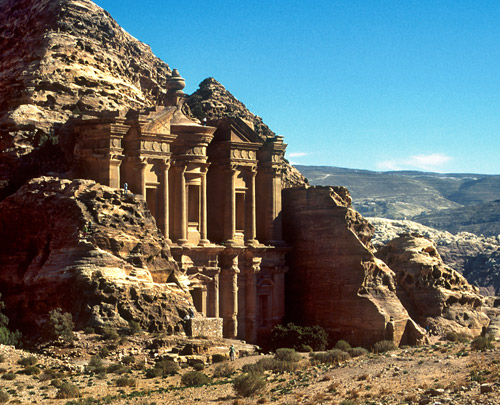蒼蘭博客
靠你有力量,心中想往錫安大道的,這人便為有福! 他們經過流淚穀,叫這穀變為泉源 之地;並有秋雨之福蓋滿了全穀 。
Jordan, Petra
Article and pictures from
http://www.atlastours.net/jordan/petra.html
佩特拉是約旦南部的一座曆史古城,距首都安曼約260公裏。隱沒於死海和阿克巴灣(今天的約旦國境內)之間的山峽中。它是約旦南部沙漠中的神秘古城之一,也是約旦最負盛名的古跡區之一。佩特拉位於幹燥的海拔1000米的高山上,幾乎是全在岩石上雕刻而成。
佩特拉為公元前4~公元2世紀納巴泰王國首都。位於約旦安曼西南 250公裏處。希臘文意為“岩石”。《舊約全書》稱“塞拉”(Sela)。公元前 1 世紀, 在國王阿雷特斯三世統治時極其繁榮,疆土曾擴大到大馬士革。公元 106年被羅馬帝國皇帝圖拉真軍隊攻陷,淪為羅馬帝國的一個行省。曾作為商路要道盛極一時。3世紀起,因紅海海上貿易興起代替了陸上商路,佩特拉開始衰落, 7世紀被阿拉伯軍隊征服時,已是一座廢棄的空城。1812年為瑞士人J.L.伯爾克哈特重新發現。

佩特拉遺跡有一條長約1.5公裏的狹窄峽穀通道。峽穀最寬處約 7米,最窄處僅 2米左右,兩側雕鑿有洞窟、岩墓等。峽穀盡頭豁然開朗,聳立著一座高約40米、寬約30米的依山雕鑿的哈茲納赫殿堂(意為金庫)造型雄偉,有 6根羅馬式門柱,分上、下兩層,直至洞頂。橫梁和門簷雕有精細圖案。穿過哈茲納赫殿堂前麵的小穀,有古羅馬劇場遺跡。劇場後麵有一片開闊地,城市依四周山坡建築而成,有寺院、宮殿、浴室和住宅等。還有從岩石中開鑿出來的水渠。在東北部的山岩上開鑿有石窟,其中有一座氣勢雄偉的三層巨窟,正麵為羅馬宮殿建築風格,是曆代國王的陵墓。現設有佩特拉石窟博物館。聯合國教科文組織已將該處列為世界文化遺產之一。
Petra is the treasure of ancient world, hidden behind an almost impenetrable barrier of rugged mountains, boasting incomparable scenes that make it the most majestic and imposing ancient site still-standing nowadays.. It has been said "perhaps there is nothing in the world that resembles it", actually, for sure, there is nothing in the world that resembles it. The rock-carved rose-red city of Petra is full of mysterious charm, it was "designed to strike wonder into all who entered it".
Petra is considered the most famous and gorgeous site in Jordan located about 262 km south of Amman and 133 km north of Aqaba. It is the legacy of the Nabataeans, an industrious Arab people who settled in southern Jordan more than 2000 years ago. Admired then for its refined culture, massive architecture and ingenious complex of dams and water channels, Petra is now a UNESCO world heritage site and one of The New 7 Wonders of the World that enchants visitors from all corners of the globe.
The approach through a kilometer long, cool, and gloom chasm (or Siq) a long narrow gorge whose steeply rising sides all but obliterate the sun, provides a dramatic contrast with the magic to come. Suddenly the gorge opens into a natural square dominated by Petra's most famous monument, The Treasury (El-Khazneh), whose intricately carved facade glows in the dazzling sun.
More facades beckon the visitor on until the ancient city gradually unfolds, one monument leading to the next for kilometer after kilometer. The sheer size of the city and the quality of beautifully carved facades is staggering and leads one to reflect on the creativity and industry of the Nabataeans who made Petra their capital.
Petra is always breathtaking, and never to be forgotten. It flourished for over 400 years around the time of Rome and Christ (pbuh), until it was occupied by the Roman legions of the Emperor Trajan in 106 AD.
The Petra basin boasts over 800 individual monuments, including buildings, tombs, baths, funerary halls, temples, arched gateways, and colonnaded streets, that were mostly carved from the kaleidoscopic sandstone by the technical and artistic genius of its inhabitants.
Petra sights are at their best in early morning and late afternoon, when the sun warms the multicolored stones, you can view the majesty of Petra as it was seen first when discovered in 1812 after being lost by the 16th century for almost 300 years!




